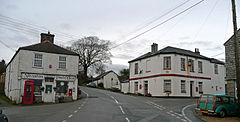Albaston
Albaston
| |
|---|---|
 Albaston post office and the Queen's Head pub | |
Location within Cornwall | |
| OS grid reference | SX 423 704 |
| Civil parish | |
| Unitary authority | |
| Ceremonial county | |
| Region | |
| Country | England |
| Sovereign state | United Kingdom |
| Post town | CALSTOCK, GUNNISLAKE |
| Postcode district | PL18 |
| Dialling code | 01822 |
| Police | Devon and Cornwall |
| Fire | Cornwall |
| Ambulance | South Western |
| UK Parliament | |
Albaston (Template:Lang-kw) is a hamlet in Cornwall, England, United Kingdom. It is in the civil parish of Calstock. It is located at Ordnance Survey grid reference SX 423 704.[1]
Albaston is about 1 mile (2 kilometres) from the centre of Gunnislake and half-a-mile (0.7 kilometres) from Gunnislake railway station, the terminus of the Tamar Valley Line from Plymouth.
History
Historically, Albaston was closely connected with the nearby mine at Drakewalls. The success of the Drakewalls mine in the late eighteenth and early nineteenth century led to the growth of the village of Albaston, including the construction of a Methodist chapel and several shops, dwellings and businesses.[2] A brewery, Edward Bowhay & Brothers, was established by 1877; this brewery had ceased operation by 1930.[3][4]
Albaston, Chapel of Rest
The grave yard in front was concentrated in 1888. Outside the Chapel, just inside the main gate, there is a large Granite Memorial Cross commemorating the 132 men who had made the supreme sacrifice in war. On the cross it bears the following inscription;
- "Thanks be to god which giveth us the victory In glorious memory of the men from the parish of Calstock who fell in the Great War 1914 - 1918. Greater Love hath no man than this that a man lay down his life for his friends"
Facilities
The village has a Methodist church, known as Tamar Valley Methodist Church. The current building was opened in 2001.[5]
The Old Post Office House is now let as a holiday home accommodating nine people.[6]
Notable residents
Christian Pentecostal leader Thomas Ball Barratt was born in Albaston in 1862, the son of a mining engineer. He moved to Norway when his father began working for a mine there and in later life became the founder of the Norwegian Pentecostal movement.[7]
References
- ^ Ordnance Survey: Landranger map sheet 201 Plymouth & Launceston ISBN 978-0-319-23146-3
- ^ Gamble, Barry. Cornish Mines: Gwennap to the Tamar. Alison Hodge Publishers. p. 77. ISBN 978-0-906720-82-0. Archived from the original on 2017-11-11.
{{cite book}}: Unknown parameter|deadurl=ignored (|url-status=suggested) (help) - ^ Arthur Cecil Todd, Peter Laws (1972). The Industrial Archaeology of Cornwall. David and Charles. p. 215. Archived from the original on 2017-01-18.
{{cite book}}: Unknown parameter|deadurl=ignored (|url-status=suggested) (help) - ^ Barber, Norman (1994). A Century of British Brewers, 1890-1990. Brewery History Society. p. 12. ISBN 978-1-873966-04-4. Archived from the original on 2017-11-11.
{{cite book}}: Unknown parameter|deadurl=ignored (|url-status=suggested) (help) - ^ "Callington Methodist Church - Home page". Callington Methodist Church. Archived from the original on 26 May 2013. Retrieved 16 January 2013.
{{cite web}}: Unknown parameter|deadurl=ignored (|url-status=suggested) (help) - ^ "Deals of the week". The Daily Telegraph. 7 July 2012. Archived from the original on 10 November 2013.
{{cite news}}: Unknown parameter|deadurl=ignored (|url-status=suggested) (help) - ^ Letson, Harry (2007). Catalysts of the Spirit: An Introduction to Pentecostal History. AuthorHouse. p. 73. ISBN 978-1-4259-6273-9. Archived from the original on 2017-11-11.
{{cite book}}: Unknown parameter|deadurl=ignored (|url-status=suggested) (help)
External links
![]() Media related to Albaston at Wikimedia Commons
Media related to Albaston at Wikimedia Commons

